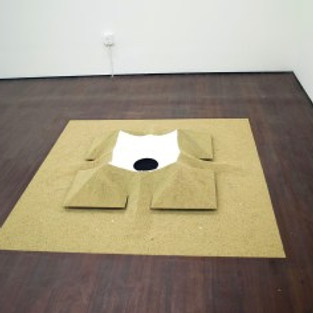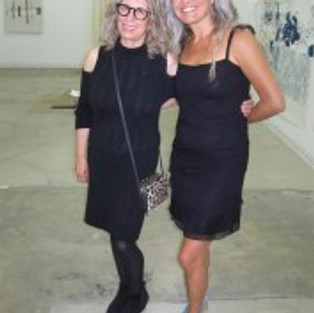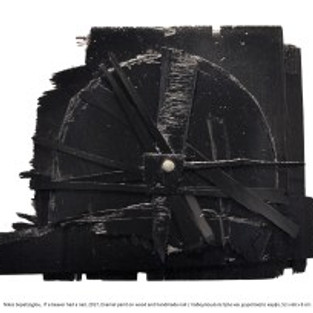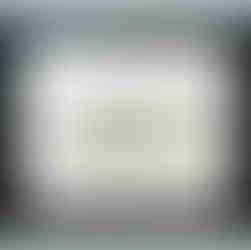
In the Stillness Between Two Waves of the Sea. Durden and Ray. Photo credit Patrick Quinn
In the Stillness Between Two Waves of the Sea: A Group show at Durden and Ray
On view through June 29th
By Patrick Quinn
The exhibit currently showing at the Durden and Ray Gallery is, in many ways, no different than most group shows. Work created by a dozen artists in a variety of mediums is displayed in a large white room. For a group show to be successful, the individual pieces should complement each other, or perhaps create an emotional juxtaposition. In this case, curators Alison Woods and Dimitra Skandali have more ambitious goals.
In the Stillness Between Two Waves of the Sea is an exchange show between artists from Greece and California, creating a dialogue between these seemingly disparate cultures. Like a cartography of places and approaches, this exhibition will map points of coexistence among chaotic global politics. Although much of the work varies greatly in terms of media and concept, most exhibit a sense of tension with regard to contemporary culture.” The phrase “cartography of places” best captures the essence of what makes this show so special. As the viewer moves from piece to piece, they become aware that a story is being mapped out. The sea, as a physical entity and as a romantic notion, is the connective thread that weaves throughout the storyline.
Two strong examples of that thread are Aliki Pappa’s installation of 38 graphite drawings of shipwrecks. These images are fused with her own personal memories to become a subconscious storyboard, defeated in a battle of time. Hanging nearby is Kio Griffith’s large format drawing of a warship built with Japanese and American parts. It references the coincidences in the artist’s familial history of the paternal (Griffith) and the maternal (Shukuya) who fought as enemies for United States and Japan during World War II.
Some artists have used discarded materials as a means to comment on the human condition. Nikos Sepetzoglou and Valerie Wilcox use humble materials that appear cobbled together, creating a mash-up of time, movement, decay, and change.
Fran Siegel’s Navigation is a vertical history of the port of Genoa inspired by Italo Calvino’s Invisible Cities. In that novel, the author explores imagination and the imaginable through the descriptions of cities by the explorer Marco Polo. The artist does the same with a work that conjures up images of antique seafaring maps.
Some works have a more political slant, such as Dimitris Katsoudas’ drawings of marine life, representing refugee children who have braved the Mediterranean waters in search of a better life.
Ty Pownall describes his architectural sand sculpture as a combination of languages of articulation with ephemeral forms and materials. Despina Nissiriou’s stop-motion video short muses on growth and memory. Nancy Ivanhoe creates wire studies using the movement of line and the process of subtraction. This particular series of work uses screen mesh as a material. In the artist’s words, “The functionality of the screen inspires the work; its purpose is to separate, divide and keep what is considered outside from intruding.”
The work with the most unique history is for all party occasions: Object lessons by artist Natasa Biza. An unusual collection of artifacts was discovered in deep storage at the Agricultural University of Athens; boxes of unexpected objects such as cookie cutters, rolling pins and mixing bowls dating back to the early 1950’s. They had arrived in post-WWII Athens as part of the Marshall Plan, which was launched in order to speed the recovery of Western European economies. The artist has photographed each item as if they were ancient relics from centuries ago, and in doing so, captures the absurdity of the situation.
The curators are also artists and each has work included in the show. Alison Woods began painting Palimpsest in 2011, then reworked it a second time in 2013. In 2015 the entire canvas was erased and prepared for a new composition. In the process of sanding down the surface, the hidden layers emerged, creating an archeological excavation of what are now the remains of a previously buried and dead composition. Hence the title of the piece which derives from the Ancient Greek word for “scraped clean.”
Taking up one corner of the gallery is Oceans and Seas II by Dimitra Skandali. An overlay of crocheted seaweed, found strings, and colorful fishing nets hang in layers from the ceiling. The nets were found on the coastal shores of different countries including the artist’s hometown on Paros island in Greece. The display may appear to be a random assemblage, but the patterns created by the colors and shadows is beautiful and very intentional.
Works from In the Stillness Between Two Waves of the Sea will travel at the Aegean Center for the Arts in Paros, Greece, giving artists an opportunity to participate in the creation of site-specific works in both countries while offering a glimpse of the concerns that inspire them in locales thousands of miles from each other.
In the Stillness Between Two Waves of the Sea runs through June 2-29, 2018 Open Saturdays 10 a.m. – 6 p.m. Other days by appointment: (510) 414-7756
#losangeles #california #losangelesartist #art #painting #AlisonWoods #losangelesart #contemporaryart #AlikiPappa #southerncalifornia #patrickquinn #abstract #collage #photography #artgallery #FranSiegel #gallery #museum #DespinaNissiriou #artandcake #artopening #artexhibition #installation #ArtandCakeLA #fineart #artists #artist #mixedmedia #arts #DimitraSkandali #environment #artreview #TyPownall #ValerieWilcox #sculpture #artmagazine #ArtandCulture #exhibition #NikosSepetzoglou #exhibit #kiogriffith #NatasaBiza #dtla #durdenandray #drawing




































































